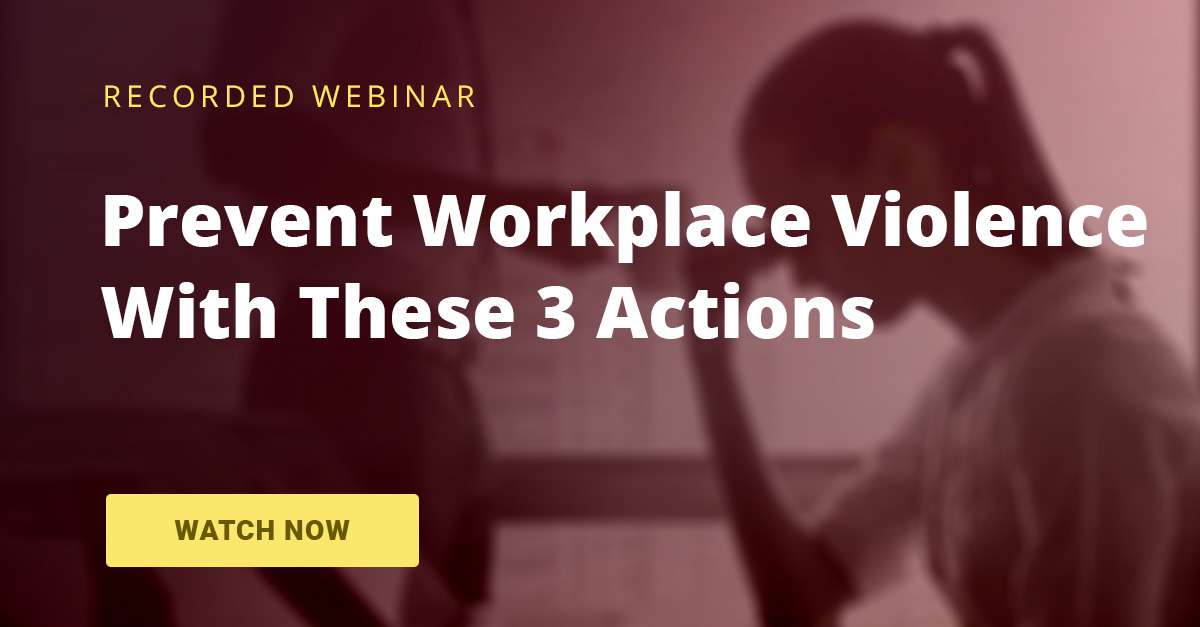What Are The 3 Stages Of Workplace Violence?
According to Occupational Safety and Health Administration (OSHA), nearly 2 million incidents of workplace violence are reported annually in the United States.
There are many more occurrences of workplace violence that go unreported; experts estimate it could be as high as 25%. Experts and data indicate that such a high percentage go unreported for several reasons, including:
- Fear of retaliation (physical or professional)
- Employees may not recognize the threat
- An effective reporting system may not be established
David Smith, founder of Professional Workplace Interaction, Inc., teaches about workplace violence in various settings including corporations, schools, governmental agencies and private businesses.
During a recent AlertFind webinar, Smith offered workplace violence prevention tips, including how to identify stages of workplace violence, creating a reporting process and the importance of a threat management team.
Organizations Must Take Prevention Seriously
Corporate America spends between $4.2 billion and 6.4 billion per year in the aftermath of workplace violence. That amount could be much lower, Smith said, if companies were more proactive about – and invested more wisely in – workplace violence prevention.
“We want to make sure we help develop a plan that is systematic and proactive. We’re trying to reduce risk by training and teaching folks, implementing policies and procedures, and other processes,” he said. He added that all threats need to be taken seriously and that a reactive plan is necessary following a threat.
Stages Of Workplace Violence
Smith identified three stages of workplace violence that employees need to be aware of:
Stage 1: Early indicators are marked by abusive language. The offender is someone who is outwardly confrontational and degrading.
“This becomes a problem because dehumanization makes it easier to put your hands on something that is not human,” Smith said. Other risk factors include spreading lies and rumors, profanity and sexually-explicit language. Even talks of suicide can be an indicator.
Stage 2: Here the outbursts have evolved from abusive to threatening, just shy of direct physical confrontation. Someone intends to harm someone else – physically, socially or through their work – and blatantly disregards organizational policies and procedures. In this stage, the instigator may use blame as a mechanism of self-defense, as if someone made them act out.
Additionally, Smith said, it’s during this stage where things are often be expressed in writing – most often in email, text or social media. This action marks the difference between abusive language and actual threats.
The threats can also be manifested by acts of business misconduct.
“I’ve seen all kinds of different traps set by one employee for another,” Smith said. “Whether it’s to trap them and make them look bad or actually to do something that could be harmful. It doesn’t have to be big-ticket items – it can just be small items that make it inconvenient for other people.”
Stage 3: It’s at this point that the threats have become violent acts. Smith noted that rehearsal of how to respond during a physical confrontation is a key component of proactive training.
“So we walk them through what they would do if they’re in the middle of somebody committing an assault, sexual assault, homicide, arson or suicide,” he said.
There are strategies of establishing possible responses that ensure they are thinking about all this in advance. “Our goal is to not have people walk around being paranoid,” Smith said. “We want you to know how you would handle a situation so you’re much better prepared when it happens.”
Programs And Reporting Protocol
Once employees are trained in how to recognize a threat and react to workplace violence, companies should implement a reporting structure. Smith recommends that teams include members from different areas of expertise in the organization, who have unique roles.
“In the center is the crisis management team and then they oversee the program and make sure that the different departments are addressing issues,” Smith said. “Reporting issues is very, very important in terms of becoming a deterrent.”
To learn more from David Smith about how companies can proactively address workplace violence, listen to our new webinar, “Preventing Workplace Violence: 3 Actions To Take Now.”

You are well on your way toward protecting your staff and organization.
Take the next step toward protecting your organization by learning more about emergency notification systems and the vital role they play in your emergency preparedness plan.
